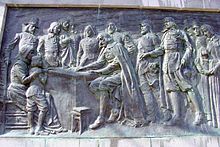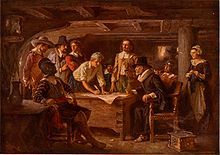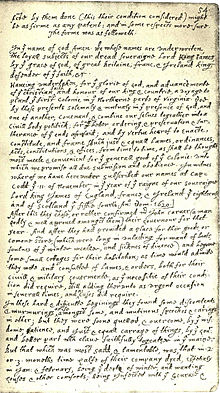- Mayflower Compact
-
 This bas-relief depicting the signing of the Mayflower Compact is on Bradford Street in Provincetown directly below the Pilgrim Monument.
This bas-relief depicting the signing of the Mayflower Compact is on Bradford Street in Provincetown directly below the Pilgrim Monument.
 The Mayflower Compact, a painting by Jean Leon Gerome Ferris which was widely reproduced through much of the 20th century
The Mayflower Compact, a painting by Jean Leon Gerome Ferris which was widely reproduced through much of the 20th century
The Mayflower Compact was the first governing document of Plymouth Colony. It was written by the colonists, later together known to history as the Pilgrims, who crossed the Atlantic aboard the Mayflower. Almost half of the colonists were part of a separatist group seeking the freedom to practice Christianity according to their own determination and not the will of the Anglican Church.[citation needed] It was signed on November 11, 1620 (OS),[1] by 41 of the ship's 101 passengers,[2][3] while the Mayflower was anchored in what is now Provincetown Harbor within the hook at the northern tip of Cape Cod.[4]
Contents
Reasons for the Compact
The Mayflower was originally bound for the mouth of the Hudson River, in land granted in a patent from the Crown to the London Virginia Company. The decision was made instead to land farther north, in what is now Massachusetts. This inspired some of the "strangers" (colonists who were not members of the congregation of religious dissenters leading the expedition) to proclaim that since the settlement would not be made in the agreed-upon Virginia territory, they "would use their own liberty; for none had power to command them...."[5] To prevent this, many of the other colonists decided to establish a government. The Mayflower Compact was based simultaneously upon a majoritarian model (even though the signers were not in the majority) and the settlers' allegiance to the king. It was in essence a social contract in which the settlers consented to follow the compact's rules and regulations for the sake of survival.[citation needed]
In November 1620, the Mayflower landed at Plymouth, named after the major port city in Devon, England from which the Mayflower sailed. The settlers named their settlement "Plimoth" or "Plimouth", old English spellings of the name.
Text
Although the original document has been lost,[6] three versions exist from the 17th century: printed in Mourt's Relation (1622),[7][8] which was reprinted in Purchas his Pilgrimes (1625),[9] hand written by William Bradford in his journal Of Plimoth Plantation (1646),[10] and printed by Bradford's nephew Nathaniel Morton in New-Englands Memorial (1669).[6] The three versions differ slightly in wording and significantly in spelling, capitalization and punctuation.[8] William Bradford wrote the first part of Mourt's Relation, including the compact, so he wrote two of the three versions. The wording of those two versions is indeed quite similar, unlike that of Morton. Bradford's hand written manuscript is kept in a vault at the State Library of Massachusetts.[11]
Modern version In the name of God, Amen. We, whose names are underwritten, the loyal subjects of our dread Sovereign Lord King James, by the Grace of God, of Great Britain, France, and Ireland, King, defender of the Faith, etc.Having undertaken, for the Glory of God, and advancements of the Christian faith and honor of our King and Country, a voyage to plant the first colony in the Northern parts of Virginia, do by these presents, solemnly and mutually, in the presence of God, and one another, covenant and combine ourselves together into a civil body politic; for our better ordering, and preservation and furtherance of the ends aforesaid; and by virtue hereof to enact, constitute, and frame, such just and equal laws, ordinances, acts, constitutions, and offices, from time to time, as shall be thought most meet and convenient for the general good of the colony; unto which we promise all due submission and obedience.
In witness whereof we have hereunto subscribed our names at Cape Cod the 11th of November, in the year of the reign of our Sovereign Lord King James, of England, France, and Ireland, the eighteenth, and of Scotland the fifty-fourth, 1620.[12]Comparison of three 17th-century versions 1622 IN the name of God, Amen. We whose names are vnder-written, the loyall Subiects of our dread soveraigne 1646 In ye name of God Amen· We whose names are vnderwriten, the loyall subjects of our dread soueraigne 1669 In the Name of God, Amen. We whose Names are under-written, the Loyal Subjects of our dread Soveraign 1622 Lord King IAMES, by the grace of God of Great Britaine, France, and Ireland King, Defender of the Faith, &c. 1646 Lord King James by ye grace of God, of great Britaine, franc, & Ireland king, defender of ye faith, &c. 1669 Lord King James, by the grace of God of Great Britain, France and Ireland, King, Defendor of the Faith, &c. 1622 Having vnder-taken for the glory of God, and advancement of the Christian Faith, and honour of our King and Countrey, 1646 haueing vndertaken, for ye glorie of God, and aduancemente of ye Christian faith and honour of our king & countrie, 1669 Having undertaken for the glory of God, and advancement of the Christian Faith, and the Honour of our K[i]ng and Countrey, 1622 a Voyage to plant the first Colony in the Northerne parts of VIRGINIA, doe by these presents solemnly & mutually in the 1646 a voyage to plant ye first colonie in ye Northerne parts of Virginia· doe by these presents solemnly & mutualy in ye 1669 a Voyage to plant the first Colony in the Northern parts of Virginia; Do by these Presents solemnly and mutually, in the 1622 presence of God and one of another, covenant, and combine our selues together into a civill body politike, for our better 1646 presence of God, and one of another, couenant & combine our selues togeather into a ciuill body politick; for our better 1669 presence of God and one another, Covenant and Combine our selves together into a Civil Body Politick, for our better 1622 ordering and preservation, and furtherance of the ends aforesaid; and by vertue hereof to enact, constitute, and frame 1646 ordering & preseruation & furtherance of ye ends aforesaid; and by vertue hearof, to enacte, constitute, and frame 1669 ordering and preservation, and furtherance of the ends aforesaid: and by virtue hereof do enact, constitute and frame 1622 such iust and equall Lawes, Ordinances, acts, constitutions, offices from time to time, as shall be thought most meet 1646 such just & equall lawes, ordinances, Acts, constitutions, & offices, from time to time, as shall be thought most meete 1669 such just and equal Laws, O[r]dinances, Acts, Constitutions and Officers, from time to time, as shall be thought most meet 1622 and convenient for the generall good of the Colony: vnto which wee promise all due submission and obedience. 1646 & conuenient for ye generall good of ye colonie: vnto which we promise all due submission and obedience. 1669 and convenient for the general good of the Colony; unto which we promise all due submission and obedience. 1622 In witnesse whereof we haue here·vnder suscribed our names. Cape Cod 11. of November, in the yeare of the raigne of our 1646 In witnes wherof we haue herevnder subscribed our names at Cap-Codd ye ·11· of Nouember, in ye year of ye raigne of our 1669 In witness whereof we have hereunto subscribed our Names at Cape Cod, the eleventh of November, in the Reign of our 1622 soveraigne Lord King IAMES, of England, France, and Ireland 18. and of Scotland 54. Anno Domino 1620.[6] 1646 soueraigne Lord king James, of England, france, & Ireland ye eighteenth and of Scotland ye fiftie fourth. Ano: Dom. ·1620·[13] 1669 Soveraign Lord King James, of England, France and Ireland the eighteenth, and of Scotland the fifty fourth, Anno Dom. 1620.[6] Note All occurrences of long s, ſ or  , have been replaced by modern s.
, have been replaced by modern s.Differences in wording Mourt (1622) Bradford (1646) Morton (1669) and honour and honour and the honour one of another one of another one another to enact to enacte do enact offices and offices and Officers here vnder hereunder hereunto Cape Cod 11. at Cap-Codd ye 11. at Cape Cod the eleventh in the yeare of the raigne in ye year of ye raigne in the Reign 18. ye eighteenth the eighteenth 54. ye fiftie fourth the fifty fourth The 'dread sovereign' referred to in the document used the archaic definition of dread—meaning awe and reverence (for the King), not fear. Also, as noted above, the document was signed under the Old Style Julian calendar, since England did not adopt the Gregorian calendar until 1752. The Gregorian date would be November 21.
Signers
The following list of 41 male passengers who signed was supplied by Bradford's nephew Nathaniel Morton in his 1669 New England's Memorial.[14] The two earlier versions of the compact, Mourt's Relation (1622) and Bradford's manuscript Of Plimoth Plantation (1646), do not give a list of signers.
- John Carver
- William Bradford
- Edward Winslow
- William Brewster
- Isaac Allerton
- Miles Standish
- John Alden
- Samuel Fuller
- Christopher Martin
- William Mullins
- William White
- Richard Warren
- John Howland
- Stephen Hopkins
- Edward Tilly
- John Tilly
- Francis Cooke (sic)
- Thomas Rogers
- Thomas Tinker
- John Ridgdale
- Edward Fuller
- John Turner
- Francis Eaton
- James Chilton
- John Craxton (sic)
- John Billington
- Joses Fletcher (sic)
- John Goodman
- Digery Priest (sic)
- Thomas Williams
- Gilbert Winslow
- Edmund Margeson
- Peter Brown
- Richard Bitteridge (sic)
- George Soule
- Richard Clark (sic)
- Richard Gardiner
- John Allerton
- Thomas English
- Edward Doten (sic)
- Edward Leister
The same list in the same order but with some corrections was provided by Thomas Prince in his 1736 A Chronological History of New-England in the form of Annals.[2] Prince added the title Mr. to ten names, which he found in a list at the end of Governor Bradford's folio manuscript: Carver, Winslow, Brewster, Isaac Allerton, Samuel Fuller, Martin, Mullins, White, Warren, and Hopkins. He attributed the lack of Mr. Bradford to Bradford's modesty. He also added Capt. to Standish. He corrected the spelling of five names: John Crackston, Moses Fletcher, Degory Priest, Richard Briterige, and Ed Dotey. In addition, he spelled Francis Cook and Richard Clarke. However William Bradford's journal Of Plymouth Plantation is definitive that both Francis Cooke and Richard Clarke had an "e" at the end of their last names.
See also
- Fundamental Orders of Connecticut (1638)
- Instrument of Government (1653)
References
- ^ The Pilgrims used the Julian Calendar, also known as Old Style dates, which, at that time, was ten days behind the Gregorian Calendar, signing the covenant "ye .11. of November" [literal])
- ^ a b Thomas Prince, A chronological history of New England in the form of annals (1736) Chronology 73, 84-86. Internet Archive. Signers sequentially numbered with titles in Morton's original order: 21 signers from Morton's first page followed by 20 signers from Morton's second page.
- ^ Bradford listed 104 passengers, including William Button, a servant of Samuel Fuller, who died 5 days before landfall, Oceanus Hopkins, born at sea, Perigrine White, born two weeks after landfall, and two seaman hired for one year, William Trevor and one Ely. If the two seaman and Perigrine White are ignored (William Button's death is offset by Oceanus Hopkins' birth), the "101 who sail'd from Plimouth in England, and just as many arriv'd in Cape Cod Harbour" listed by Prince are left.
- ^ Young, Alexander (1841). Chronicles of the Pilgrim Fathers of the Colony of Plymouth from 1602 to 1625. pp. 117–124. http://books.google.com/books?id=XGQMAAAAYAAJ&pg=PA117.
- ^ Bradford, William (1898). "Book 2, Anno 1620". In Hildebrandt, Ted (PDF). Bradford's History "Of Plimoth Plantation". Boston: Wright & Potter. http://faculty.gordon.edu/hu/bi/Ted_Hildebrandt/NEReligiousHistory/Bradford-Plimoth/Bradford-PlymouthPlantation.pdf. Retrieved 2006-06-01.
- ^ a b c d George Ernest Bowman, The Mayflower Compact and its signers (Boston: Massachusetts Society of Mayflower Descendants, 1920). Photocopies of the 1622, 1646 and 1669 versions of the document. Signers on two pages, three columns per page.
- ^ William Bradford, Edward Winslow (printer G. Mourt [George Morton], Relation or Iournall of the beginning and proceedings of the English Plantation setled at Plimoth in New England, Early English Books Online, p.4
- ^ a b Henry Martyn Dexter, [G. Mourt = George Morton], Mourt's Relation or Journal of the Plantation at Plymouth, 1865, pp.6-7, a reprint using original typeface, paragraphs, punctuation, spelling and embelishments, but not pagination. This edition lists differences in wording between the three versions and discusses passengers vs signers.
- ^ Samuel Purchas, Hakluytus Posthumus or Purchas His Pilgrimes, Vol. XIX (Glasgow:James Maclehose, 1906) 313-314. Reprint of 1625 edition except that letters i, j, u, and v are used according to modern custom, contracted letters extended, printers' errors corrected, and repaginated from original four volumes to twenty volumes (I.xxvi).
- ^ William Bradford, Bradford's History "Of Plimoth Plantation" from the original manuscript (Boston: 1901) page 110 (photocopy of manuscript page follows). Passengers listed on pages 530-540. No annotations. Official printing by the Commenwealth of Massachusetts. This printing of compact is identical to the 1856 version by the Massachusetts Historical Society. Spelling and contractions follow manuscript except for modern u/v usage. Capitalization and punctuation differ from manuscript. A faithful transcription is at Mayflower Compact (1620).
- ^ History of Plimoth Plantation: manuscript, 1630–1650. State Library of Massachusetts Catalog
- ^ The Mayflower Compact — U. S. Constitution Online
- ^ Mayflower Compact (1620) transcription of William Bradford's manuscript version by Caleb Johnson
- ^ Morton, Nathaniel (1669). "Chapter 2". In Rhys, Ernest. New England’s Memorial. http://www.bibliomania.com/2/1/60/107/20817/1.html. The 1772 reprint of Morton has a totally different order.
External links
Richard Hakluyt Mayflower Mayflower CompactPlymouth Colony Connecticut Colony Categories:- 1620 in the Thirteen Colonies
- History of the Thirteen Colonies
- Plymouth Colony
- Political charters
- United States historical documents
- Mayflower
Wikimedia Foundation. 2010.

